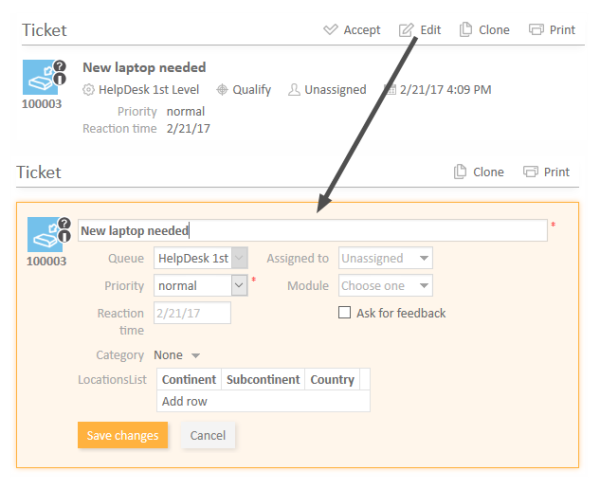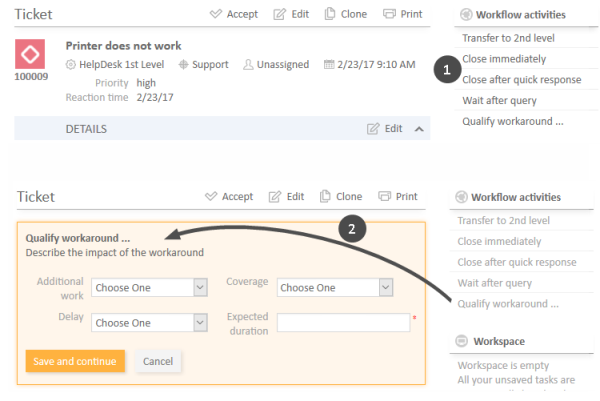Updating Tickets
Accessing Existing Tickets
In order to work on a ticket, you need to open it first. There are several ways to open an existing ticket:
- Opening a ticket from the ticket list or grid.
- Opening a ticket from the Quick Search results.
- Opening a ticket from a result table containing tickets (e.g., on a customer page, in the Section for Related Tickets of a resource page, or in the Detailed Search).
- Opening a ticket using the Jump to ticket link in the Section for Related Tickets of another ticket.
Becoming the Assigned Engineer of a Ticket
Being the assigned engineer means that you are in charge of the ticket at this moment. Tickets can be assigned to an engineer manually and automatically.
Automatic assignments are configured by your CM administrator. Therefore, they depend on the configuration of your individual CM system, e.g., you might get assigned as the ticket's engineer when you execute a certain workflow activity or when you create a ticket.
Manual assignments can be performed in several ways:
- (1) Accepting a ticket in the ticket header (only unassigned tickets, only assignment to yourself)
Click Accept in the ticket header. - (2) Accepting a ticket in the ticket list (only unassigned tickets, only assignment to yourself)
Click the arrow icon in the upper right corner of the ticket in the ticket list. - (3) Changing the engineer of a ticket (any ticket, assignment to yourself or another engineer)
Click Edit to make the ticket data editable. Then, select an engineer from the Assigned to drop-down list. If the ticket is already assigned to an engineer, you have to remove the engineer's name first by clicking the red cross next to the name.You can only change the engineer if you have the required permission.
Figure 53: Accepting a ticket
The CM system might send you an email when you are assigned or removed as an engineer. The exact behavior depends on the configuration of your system.
Editing Ticket Data
You can edit ticket data in the Ticket Header and in the Details Section. Click the Edit link in the upper right corner of the desired section to edit its data. The section's background turns yellow to indicate that it is in edit mode. Edit the ticket data as required (see The Different Data Fields for details about the different types of data fields). Click Save changes to save the new data. The section background turns gray again (view mode).
Figure 54: Editing ticket data
You can only edit ticket data if you have the required permission.
Performing Basic Actions
Cloning a Ticket
You can clone a ticket to quickly create a new ticket which is very similar to an existing ticket. Usually, the ticket data (Ticket Header and Details Section) and the customer data (main customer and additional customers) are copied from the original ticket to the cloned ticket. Other content such as attachments, comments, emails, and time bookings are not copied to the new ticket. There is no ticket relation or other technical connection between the two tickets. Click the Clone link in the upper right corner of the ticket to duplicate it. The cloned ticket is opened in edit mode. Change its data as required and add a comment. Click Create to save the new ticket.
The exact behavior of the cloning feature, i.e., which content is copied to the new ticket, depends on the individual configuration of your CM system.
Printing a Ticket
You can print a ticket by clicking the Print link in the upper right corner of the ticket. A pop-up window is displayed where you can select the desired printer.
Performing Workflow Activities
Workflow activities are used to move tickets through the business process. The available workflow activities depend on the business process (workflow) implemented in your CM system.
The displayed workflow activities depend on:
- the ticket opened in the main working area
- the current queue of the ticket
- the current position of the ticket within the workflow
- your permissions
- if you are added as an additional engineer to the ticket
Open the ticket in the main working area to display the workflow activities which you can carry out for this particular ticket in this moment. The available workflow activities are displayed on the left, in the Workflow activities box (1). Click a workflow activity to execute it. This will have one of the following effects:
- The workflow activity is executed immediately. You see the next workflow activities according to the new position of the ticket in the business process.
- An ACF (Activity Control Form) opens (2). You have to fill out the ACF before the workflow activity can be executed.
- You see an info message that certain criteria are not fulfilled yet, e.g., you might have to fill out certain data fields or perform certain actions before you can execute a workflow activity.
In the following cases, no workflow activities are displayed:
- The business process for this ticket is already completed, e.g., the ticket is closed.
- The workflow activities at this point in the process depend on conditions which are not yet fulfilled.
- You do not have the permissions needed to see the workflow activities at this point.
Figure 55: Workflow activities and ACF
Filling in an ACF
Workflow activities can be configured to open an ACF (Activity Control Form). ACFs are used to update ticket data. They allow you to easily locate the fields which you need to fill out in order to perform this workflow activity. It depends on the individual configuration of your CM system which ACFs are available. Examples for the usage of ACFs are workflow activities where you qualify a workaround, enter the feedback received by a customer, or prepare a quote.
The ACF is displayed above the Ticket Header. It has a yellow background to indicate that it is editable. You have to fill in the data in the ACF before you can continue. Click Save and continue to save your changes and execute the workflow activity. If you click Cancel, the ticket will remain in its previous position, i.e., the workflow activity is not executed.


